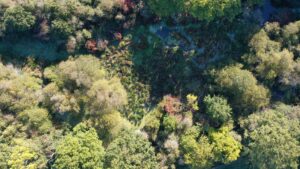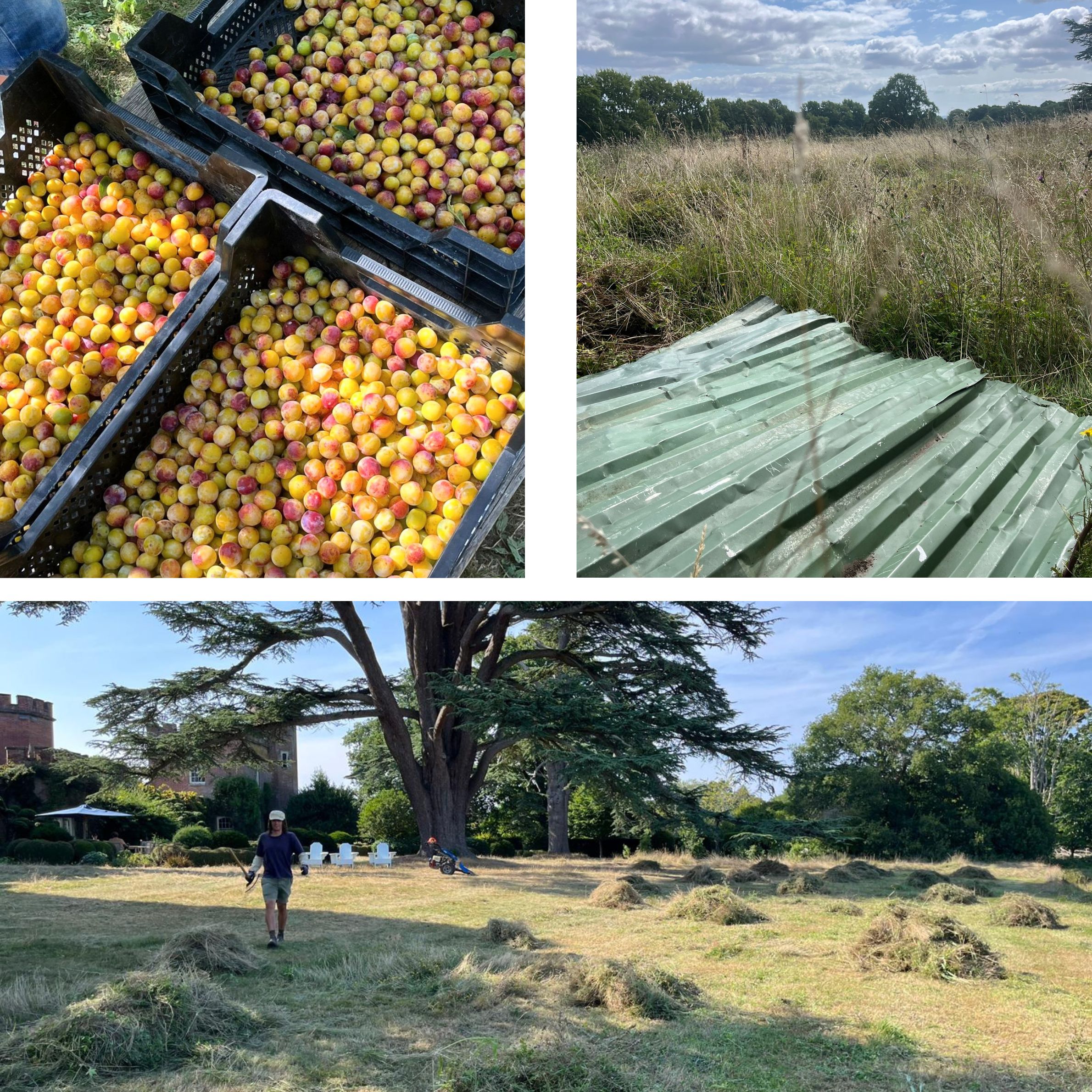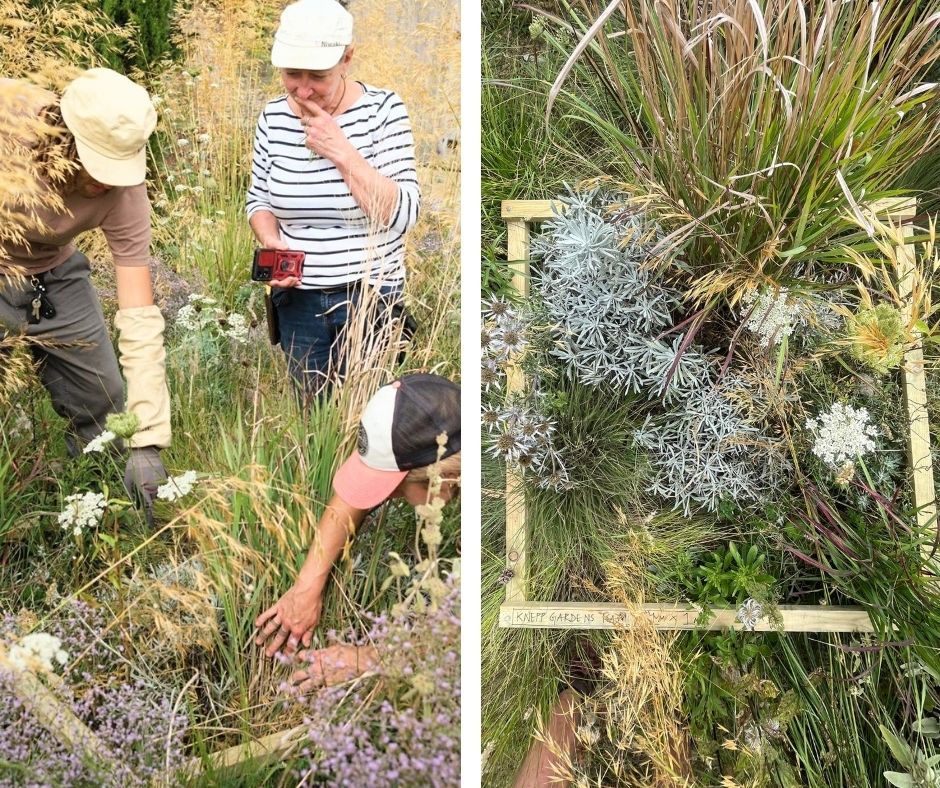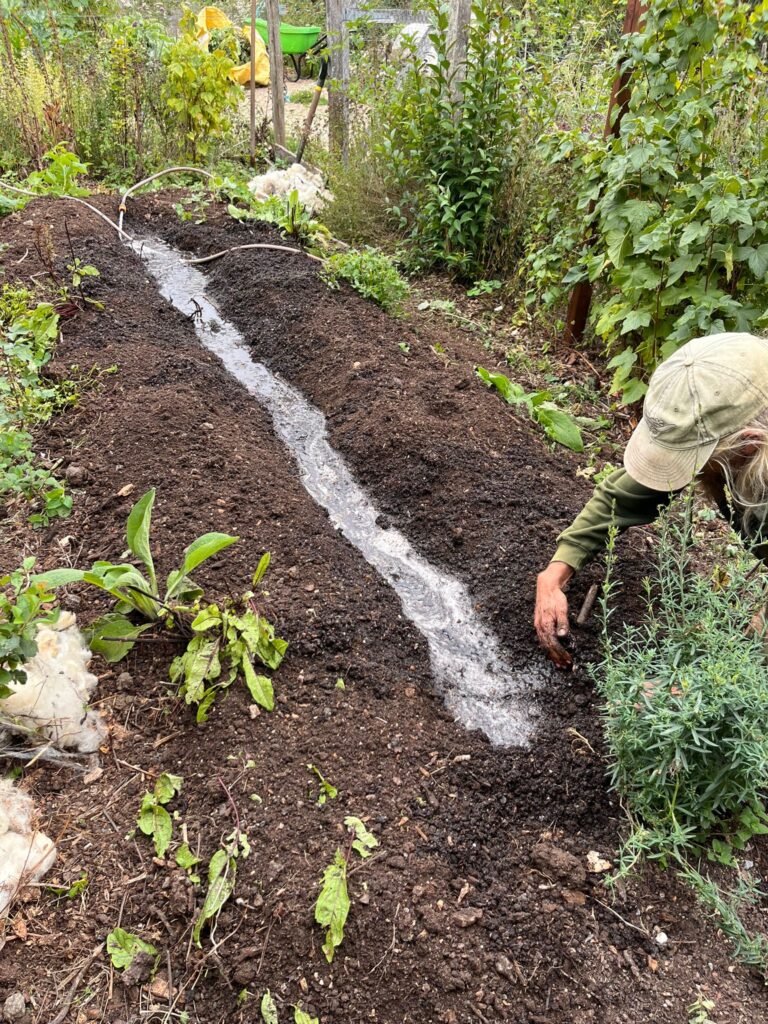
Authors’ hopes for 2026
Wild hopes for the year ahead Published January 2026 In 2025 we hosted some of the biggest movers and shakers in the nature recovery movement
Home / August: Soils, Surveys and Meadows

Moy Fierheller | Deputy Head Gardener
Published September 2025
Visit Knepp’s rewilded Walled Garden
As the Perseid meteor shower hurtles through the night sky, with fragments of pea-sized rock travelling at 58km a second and heating up to over 1500°C, the temperatures in the UK begin to rise again. The meadows are brushed with a dusty sheen, faded-corduroy greens, sandy-hued ripples of grasses.
August is a busy month for us outside the Walled Garden: cutting meadows and harvesting soft fruits from the orchard. There are advantages to the warm dry weather – we have bumper crops of greengages and Mirabelle and Merryweather plums. We’ve also been wrangling into shape the four enormous wisterias that cloak the walls of the house, as well as curbing the enthusiasm of the climbing roses, Virginia creeper and common jasmine from a cherry picker that rises a breathtaking eighteen metres high.
In the meadows, the cuttings have been significantly less than last year. Ordinarily we would collect up the cut biomass from our wildflower-rich areas and strew it on other paddocks where grasses are dominant. It’s a cheap and efficient way of increasing plant diversity. Left for one to two weeks, the drying seeds fall onto the newly exposed soil and germinate the following spring. But the dry year has impacted the number of species, with common knapweed (Centaurea nigra) and creeping cinquefoil (Potentilla reptans) becoming dominant. Both plants are brilliant for pollinators, but the greater the diversity of plant species in a meadow, the greater the range of insects it can support and, in turn, this benefits the insect predators – from birds and bats to dragonflies, toads, frogs and small mammals. And snakes. We use a power scythe to cut the four areas around the castle and have put out some reptile shelters of corrugated roofing scrap so any grass snakes, slow worms and amphibians can take shelter from the blade. We’re careful to begin cutting from the centre outwards to give wildlife the opportunity to retreat.
We’ve tried experimenting to reduce the dominance of the creeping cinquefoil this year by digging over an area and removing as many as possible – they have extraordinarily long and tenacious roots – and strewing with some hay kindly donated by our neighbours at Wadhurst Park who have a well-established species-rich meadow. Hopefully the seed will establish and spread, competing with the cinquefoil.

In the rewilded Walled Garden, the prairie conditions are encouraging the ornamental grasses and we gradually become submerged as the month progresses, the seedheads reaching eye-level, the pathways embraced by plants that slow your pace and lend the garden an enigmatic air of secrets round every corner. The American tall tickseed (Coreopsis tripteris), shoulder high, with its bright yellow daisy flowers and chocolate-button centres like giant cartoon bees, has self-seeded everywhere this year. The narrowleaf ironweed (Vernonia lettermannii) from rocky and sandy floodplains in Arkansas and Oklahoma has bulked up magnificently, and great stands, almost a metre and a half wide and the same high, parade their royal purple, aster-like flowers. Avoiding some of these larger plants, we’ve undertaken a series of quadrat surveys of floral diversity, identifying the number of planted and volunteer species per square metre.
We’ve been carrying out surveys of our wilding garden experiment from the very beginning in 2020, including everything from soils and wildlife to logging ‘grazing’ hours, and now we’re starting to try and link data to form judgements on how we manage the garden. Some of the quadrats were chosen based on areas where we’ve had soil samples analysed; others represent different substrates. We recorded our highest plant diversity – twenty-five species in one quadrat – in what we call Hitchmough Ridge – the ridge of 75% crushed concrete and 25% sand in the rewilded Walled Garden. With the help of these surveys we hope to build up a long-term picture of fluctuations in diversity, whether we see species change, and how this reflects in insect diversity.

With the continuing drought (the MET office reports consistent above-average temperatures so far this year), Suzi Turner, Deputy Head Gardener in charge of edibles, has been looking at different ways to use water and increase nutrients in the Kitchen Garden. We’ve been given some wool from a flock of sheep that are annually brought onto the estate to graze around the solar photovoltaic panels that provide electricity in a field in the Southern Block. Wool can be used in gardens in two ways – as a mulch or a fertiliser added to compost or soil.
Holding up to 30% of its weight in water, a layer of wool around the base of plants can retain moisture in dry spells, regulate soil temperature – in both hot or cold weather – and supress germination of competing seedlings. Suzi made a small test bed when she planted out the winter brassicas. Half of them have thick white collars like Shakespearian ruffs; the remainder have a layer of wool buried in a trench beneath their roots. There’s some evidence of the fibrous nature of the wool being a slug repellent, although when it’s very wet it can also act as a slug refuge. We’ll monitor the responses as the weather changes into autumn to see what effects the wool has had.
Wool can also be used as a sustainable and renewable alternative to peat because of its high nitrogen content (9-11%) and capacity to hold water. Since it biodegrades slowly – anything from three months to two years, depending on conditions – it can act as a slow-release fertiliser. It has a relatively high potassium content, as well as iron, sodium and phosphorous which are all important elements for plant health and growth. And it can improve aeration and drainage in soils, particularly heavy ones like clay. This facilitates the movement of soil biota. As usual, the devil is in the details. Coarse wool from hill breeds of sheep has better structure and texture than fine wool and is slower to break down. It’s more readily available, too, as it’s less likely to be used for the clothing industry. Wool that has been bundled needs to be separated before it’s added to compost or soil otherwise it’s likely to compact into clumps that can lead to poor aeration. Overall, it’s going to be interesting to follow its progress in the garden and see how visitors respond to the visual aspect. We’ve covered some mulched areas with wood chip to show alternatives.
Suzi has also been adding an irrigation trench to the mounded bed in the fruit cage. Ben Henderson-Butler, the fantastic head of vegetable production at the Lost Gardens of Heligan, joined us and Knepp’s organic Market Garden team for a week, sharing water wisdom from Southeast Asia. He owns a rice and duck permaculture farm in Thailand and he and Suzi created a water trench between two mounded areas. The top few inches of soil in our annual vegetable beds tends to dry out and it takes a lot of repeated watering to rehydrate. Using this trench, and flooding it weekly, will provide moisture to roots and soil biota as it gets drawn into the banks.

The presence of water is essential to ensure good soil health but diversity of soil organisms and fungi are also fundamental for making nutrients available to plant roots. Amanda Lowe, a Knepp volunteer studying soil science, provided us with a summary of a soil analysis report for two of the larger beds in the Kitchen Garden. We’ve long suspected that the soil biota in these beds is not as it should be, and the report has now confirmed that the main biology is bacteria, with a lack of larger microorganisms and very little fungi. A productive soil really needs a good balance of all three. Whilst the dry conditions haven’t helped the situation, it’s possible to detect dormant spores in a sample, and these are also minimal.
We’ve talked about these challenges before – soil compaction preventing movement of soil organisms, and the presence of established yew trees within the beds competing for water and nutrients. The home-made compost we’ve added to the beds over the past few years isn’t holding on to moisture, possibly down to lack of volume. Introducing more soil biota from proven or analysed sources (for example, compost that is certified by the Chartered Quality Institute) is pointless without supplying the right conditions in which the biota can survive and thrive. But now we’ve identified the specific problems and deficiencies we can plan a strategy to get the soil in much better shape.
Testing and observation are what help us learn and move forward, and within the gradient of productivity that we want to achieve between both sides of the Walled Garden, we want to push the boundaries as far as we can. From low-nutrient, free-draining aggregate that helps increase plant diversity in the rewilded garden through to high-nutrient, water-retaining soils where edible plants flourish in the kitchen garden, we chase the rainbow – to increase above and below-ground opportunity for wildlife.
Photos courtesy of Suzi Turner, Charlie Harpur, Moy Fierheller.
Garden Tips – September 2025
What we’re reading
Wadhurst Park Grasslands
(PDF) The Feasibility of Large-Scale Composting of Waste Wool
The Use of Wool in Compost and other Alternative Applications | OSU Small Ruminant Team
Explore the Heligan Grounds | The Lost Gardens of Heligan
Compost standards at the heart of sustainability | CQI | IRCA
Gravel Garden Maintenance – Beth Chatto Gardens
Cranfield University showcases groundbreaking toilet technology at RHS Chelsea Flower Show

Wild hopes for the year ahead Published January 2026 In 2025 we hosted some of the biggest movers and shakers in the nature recovery movement

Moy Fierheller | Deputy Head Gardener December: Garden Lessons Published January 2026 Visit Knepp’s rewilded Walled Garden December is like a wavering bride-to-be, one moment

knepp’s 2025 in numbers 2025 has been quite a year. Our butterfly summer was record-breaking, we re-launched the Knepp Wilding Podcast with Isabella Tree as
Knepp Wildland Safaris, our gardens and campsite are all about the quiet and patient observation of nature.
Some of the species we are likely to encounter are shy or can be frightened by loud noises or sudden movements. Our campsite with open-air fire-pits, wood-burning stoves and an on-site pond is unsuitable for small children.
For this reason, our safaris, garden visits, holiday cottages and campsite are suitable only for children of 12 and over.
You’ll receive relevant offers and news by email. This will include information about the Rewilding Project, online store products, the Wilding Kitchen Restaurant / Cafe, and other exciting experiences / events across the Knepp Castle Estate. For more information, view our Privacy Policy.